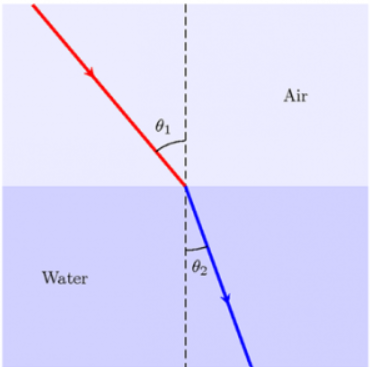
The phenomenon by which the incident light falling on a surface is sent back into the same medium is known as
A. Reflection
B. Refraction
C. Dispersion
D. None
Answer
223.8k+ views
Hint: Optical phenomena happen when light waves interact with matter. Examples of this are Reflection, Refraction, Dispersion, etc.
Complete Step by step solution:

Reflection is the phenomenon by which any incident wave-front falling on a surface is sent back into the same medium where it originated. There are three laws of reflection that are
(i) The incident ray, the reflected ray and the normal at the point of incidence, all lie in the same plane.
(ii) Angle of incidence is equal to Angle of reflection.
(iii) The reflected ray and the incident ray are on the opposite sides of the normal.

Refraction is the phenomenon of bending of a light wave or change in its direction when it is going from one medium to another. A lens is a refractive surface used for many purposes, such as magnification.

Dispersion is the phenomenon in which the white light when passed through a glass prism splits into its spectrum of colours. This phenomenon along with refraction is responsible for the formation of rainbows in the sky.
So the answer to the given question is Reflection, option (A)
Note: Reflection is the bouncing back of light in the same medium when incident on any surface.
Refraction is the bending of light when it goes from one medium to another.
Dispersion is the splitting of white light into its spectrum of colours when passed through a glass prism.
Complete Step by step solution:

Reflection is the phenomenon by which any incident wave-front falling on a surface is sent back into the same medium where it originated. There are three laws of reflection that are
(i) The incident ray, the reflected ray and the normal at the point of incidence, all lie in the same plane.
(ii) Angle of incidence is equal to Angle of reflection.
(iii) The reflected ray and the incident ray are on the opposite sides of the normal.

Refraction is the phenomenon of bending of a light wave or change in its direction when it is going from one medium to another. A lens is a refractive surface used for many purposes, such as magnification.

Dispersion is the phenomenon in which the white light when passed through a glass prism splits into its spectrum of colours. This phenomenon along with refraction is responsible for the formation of rainbows in the sky.
So the answer to the given question is Reflection, option (A)
Note: Reflection is the bouncing back of light in the same medium when incident on any surface.
Refraction is the bending of light when it goes from one medium to another.
Dispersion is the splitting of white light into its spectrum of colours when passed through a glass prism.
Recently Updated Pages
JEE Isolation, Preparation and Properties of Non-metals Important Concepts and Tips for Exam Preparation

Isoelectronic Definition in Chemistry: Meaning, Examples & Trends

Ionisation Energy and Ionisation Potential Explained

Iodoform Reactions - Important Concepts and Tips for JEE

Introduction to Dimensions: Understanding the Basics

Instantaneous Velocity Explained: Formula, Examples & Graphs

Trending doubts
JEE Main 2026: City Intimation Slip Releasing Today, Application Form Closed, Exam Dates, Syllabus & Eligibility

JEE Main 2026 Application Login: Direct Link, Registration, Form Fill, and Steps

Understanding the Angle of Deviation in a Prism

How to Convert a Galvanometer into an Ammeter or Voltmeter

Ideal and Non-Ideal Solutions Explained for Class 12 Chemistry

Hybridisation in Chemistry – Concept, Types & Applications

Other Pages
JEE Advanced Marks vs Ranks 2025: Understanding Category-wise Qualifying Marks and Previous Year Cut-offs

JEE Advanced 2026 - Exam Date (Released), Syllabus, Registration, Eligibility, Preparation, and More

JEE Advanced 2026 - Exam Date (Released), Syllabus, Registration, Eligibility, Preparation, and More

Dual Nature of Radiation and Matter Class 12 Physics Chapter 11 CBSE Notes - 2025-26

Understanding Electromagnetic Waves and Their Importance

Understanding Atomic Structure for Beginners




